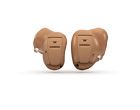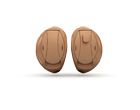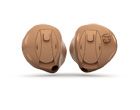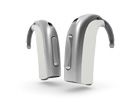![]()
![]()
![]()
Use LEFT and RIGHT arrow keys to navigate between flashcards;
Use UP and DOWN arrow keys to flip the card;
H to show hint;
A reads text to speech;
47 Cards in this Set
- Front
- Back
|
What are the basic components of a hearing aid?
|
Microphone, Amplifier, Receiver and Battery
|
|
|
Probe-Microphone Measures
|
Measures the gain and output of a hearing aid. Helps to make sure patient is hearing at the level the audiologist expects.
|
|
|
What does a microphone do?
|
Picks up environmental sounds and turns the sound waves into an electrical signal.
|
|
|
What does and amplifier do?
|
Boosts the Hz collected from the microphone.
|
|
|
Whate does a receiver do?
|
Converts the amplified signal back into a sound wave.
|
|
|
What is a telecoil?
|
A programable feature that allows hearing aid to directly communicate with the telephone, it cuts the microphone off from outside noise.
|
|
|
Describe the control of frequency-specific gain.
|
An internal control that allows audiologist to choose the number of channels. Can select smaller amounts of pitch to get clearer sound, can select to pick up sounds at the whisper level.
|
|
|
Describe the compression feature of a hearing aid.
|
Programable feature that controls the level of sounds. EX: compresses the sound level of a siren.
|
|
|
Describe the directional microphone technology feature of a hearing aid.
|
Most important feature for background noise: Gives pt. the option of hearing background noise depending on how busy their environments are. Uses multiple microphones.
|
|
|
What are the 6 styles of hearing aids?
|
1. Body aid
2. Eyeglass aid 3. Behind-the-ear 4. In-the-ear 5. In-the-canal 6. Completely-in-the-canal |
|

|
Completely-in-the-canal
- smallest, pull on wire to get out |
|

|
In-the-canal
- a little larger than CITs. |
|

|
In-the-ear
- full shell vs. half shell (either covers full/half of concha bowl) |
|

|
Behind-the-ear:
- leaves ear relatively open to prevent barrel effect. - doesn't boost lower freq., more naturally heard. -higher freq. are more boosted -durable, can fix indiv. parts and adjust ear mold for growth -easy to clean |
|
|
How often to you have to refit babies?
|
As newborns every 2 weeks. From 8mos to 6 yres every 6 months.
|
|
|
How would you specially fit someone who had one dead ear and one ear with hearing loss?
|
Bi-cross aid: A microphone is worn on the unaidable ear and entering sound is routed by FM transmitters to a microphone, amplifier and receiver worn on the better ear, which also acts as a hearing aid.
|
|
|
How would you specially fit someone who had one dead ear and one good ear?
|
Cross aid: A microphone is worn on the impaired ear and entering sound is routed by FM transmitters to an amplifier and receiver worn on the better ear.
|
|
|
How would you specially fit someone who had outer ear (air conduction) issues?
|
Bone conduction aids - rod goes into mastoid to send signals through bone conduction.
|
|
|
What is a middle ear implant?
|
It hooks on to stapes footplate and amplifies sound. Huge liability issue, mostly done for cosmetic reasons.
|
|
|
What type of hearing loss would qualify for a cochlear implant?
|
severe to profound hearing loss
|
|
|
What are the 3 modifications of earmolds?
|
1. Lower frequency modifications
2. Mid-frequency modifications 3. High-frequency modifications |
|
|
What does a low-frequency modification do?
|
Venting, prevents echo effect that causes patient to feel like they are in a barrel.
|
|
|
What does a mid-frequency modification do?
|
Dampening, filters are placed in ear hook to reduce the output and intake of the hearing aid.
|
|
|
What does a high-frequency modification do?
|
Acoustic horn is used to emphasize the high frequencies.
|
|
|
What are the 5 sizes of hearing aid batteries?
|
675
13 312 10 5 |
|
|
T/F: The smaller the battery the quicker it goes dead.
|
True
|
|
|
Why would we use Output Sound Pressure Level (OSPL 90) to test Hearing aids?
|
To test for loud sounds because over exposure to loud dB causes hearing loss at certain durancies.
|
|
|
Why would we test High Frequency Average (HFA)? OSPL 90
|
Allows one to see the maximum output the HA can generate. Want to be sure HA doesn't exceed the patients loudness discomfort level.
|
|
|
Why would we test HFA FOG (full on gain)?
|
Allows us to estimate the maximum power of the hearing aid. HA are adjusted to deliver the greatest amount of gain for those frequencies which a person has the poorest thersholds.
|
|
|
Why would we test HFA RTG (reference-test gain)?
|
Test how aid performs at a level closer to typical speech.
|
|
|
Why would we test Frequency Range?
|
So we know what the lowest frequency and highest frequencys that the hearing aid can pick up.
|
|
|
Why would we test Total Harmonic Distortion? (THD)
|
Unwanted signals created by a hearing aid.
|
|
|
Why would we test for Equivalent Input Noise (EIN)?
|
The Equivalent Input Noise is the amount of noise which is present in the hearing aid without any input present.
|
|
|
Describe HIOBASIC orientation.
|
H- hearing expectations
I- instrument options O- occlusion effect B- batteries A- acoustic feedback S- system troubleshooting I- insertion/removal C - cleaning/maintenance |
|
|
HIOBASIC
H |
Hearing Expectations - Review expectations and limitations of hearing aid.
|
|
|
HIOBASIC
I |
Instrument Options- Describes the function of each part and ensurest that the pt. can adjust controls.
|
|
|
HIOBASIC
O |
Occlusion Effect -
|
|
|
HIOBASIC
B |
Batteries - Patient practices inserting and removing batteries
|
|
|
HIOBASIC
A |
Acoustic Feedback - Used to determine how good the HA is working.
|
|
|
HIOBASIC
S |
System troubleshooting - patient learns to troublshoot device for common problems such as weak or no sound and feedback.
|
|
|
HIOBASIC
I (2nd) |
Insertion/ Removal - patient learns to get in and out. 2nd biggest complaint, patient can't remove HA.
|
|
|
HIOBASIC
C |
Patient learns how to clean earwax from HA and how to properly maintain it by keeping it away from moisture.
|
|
|
Hardwire Systems
|
pocket talker, box w/ amplifier and receiver and headphones.
|
|
|
Induction Loop Systems
|
infrared systems looped into areas (theatres, churches, etc.)
|
|
|
FM Systems
|
Typicall wireless; consists of microphone and or headphones. Cuts down distance between speaker and listener.
|
|
|
Television
|
TV ears, wireless headphones
|
|
|
Alerting Signals or devices
|
Allows hearing impaired to be aware of alarms, doorbells and phones through the use of strobe lights/ vibrations.
|

